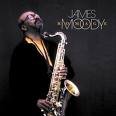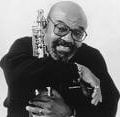Jazz saxophone legend James Moody is perhaps best known for his signature song, “Moody’s Mood for Love,” an improvisation on the chord progressions in “I’m in the Mood for Love.”
Born in Savannah, Georgia in 1925, and raised in Newark, New Jersey, Moody took up the alto sax at 16, switching to tenor saxophone a few years later. In 1946, he joined Dizzy Gillespie’s big band, beginning an association that afforded young Moody worldwide exposure and ample opportunity to shape his improvisational genius.
In 1947, Moody recorded with Milt Jackson for Dial Records. One year later, he debuted his own band, James Moody and His Bop Men. In 1963, he rejoined Gillespie and performed off and on with the trumpeter’s quintet for the remainder of the decade.
In Las Vegas, beginning in 1973, he did a seven-year stint with the Las Vegas Hilton Orchestra, doing shows for Bill Cosby, Ann-Margaret, John Davidson, Glen Campbell, Liberace, Elvis Presley, the Osmonds, Milton Berle, Redd Foxx, Charlie Rich, and Lou Rawls, to name a few. In 1985, he received a Grammy Award nomination for "Best Jazz Instrumental Performance" for his playing on Manhattan Transfer’s album Vocalese.
Moody’s own debut album Something Special was released in 1986. His follow-up record, Moving Forward, showcased his hearty vocals on “What Do You Do” and his interpretive woodwind wizardry on tunes like “Giant Steps” and “Autumn Leaves.”
Moody moved to San Diego in 1989, where he married Linda Moody in San Carlos.
His 1995 album Young at Heart paid tribute to songs associated with Frank Sinatra. In 2001, his song “Moody’s Mood for Love” made the Grammy Awards Hall of Fame.
Still living in San Carlos in 2009, Moody was nominated for four Grammy Awards, including a 2009 nod for Best Jazz Instrumental Solo (“Bebop” from Live at the 2007 Monterey Jazz Festival by the Monterey Jazz Festival 50th Anniversary All-Stars).
Battling pancreatic cancer in February 2010, Moody underwent an operation at the UCSD Thornton Hospital to have his gall bladder removed, as well as a double bypass performed on his digestive system. Later that year, he released a new album, 4B. The album received a 2011 Grammy Award nomination, for Best Jazz Instrumental Album.
Moody died at the San Diego Hospice on the afternoon of December 9, 2010. He was 85, survived by his wife of 22 years, his children, grandchildren, and a great-grandchild.
Charles McPherson received a message from Moody in the weeks prior to his death. “A friend of his called to ask about a saxophone repairman in town, and who did I go to, and who would I recommend.” Best known perhaps for his work with Charles Mingus, McPherson is a Detroit-raised modern jazz saxist who relocated to San Diego in 1978. He and Moody were friends. He says the phone message confused him at first. Why hadn’t Moody called?
“With hindsight, now I know that he couldn’t call me himself. He was too weak. But he was still concerned about mundane things like the saxophone and it being fixed, and for what? He still wanted to play?” The answer was yes. “Even in sickness, the flame was still alive for him.” McPherson says he later asked Moody’s wife Linda about the odd request. “She was saying that what was wrong...he was too weak to really finger well. She couldn’t bring herself to tell him that, and [Moody] was thinking it was something wrong with the horn.”
Moody may have lived out his final years in San Diego more or less under the radar, but out of town, it was a different story. In 1998 the National Endowment for the Arts named him a Jazz Master, and “Moody’s Mood for Love,” covered by the likes of Van Morrison and Aretha Franklin and Amy Winehouse and many more, landed in the Grammy Hall of Fame in 2001. Moody was also recognized by the International Jazz Hall of Fame.
“He was in on the very beginnings of the bebop era,” says McPherson of Moody’s 64-year career. “He was in one of Dizzy Gillespie’s big bands, which was probably the first bebop big band.”
The James Moody Democracy of Jazz Festival debuted October 15 through 21, 2012, at the New Jersey Performing Arts Center, near where Moody grew up in Newark, with performers including George Benson, Manhattan Transfer, and David Sanborn.
 Facebook
Facebook X
X  Instagram
Instagram TikTok
TikTok Youtube
Youtube



